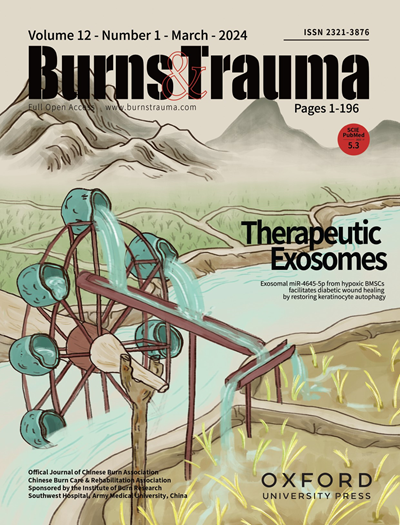Type I collagen extracellular matrix facilitates nerve regeneration via the construction of a favourable microenvironment
IF 9.6
1区 医学
Q1 DERMATOLOGY
引用次数: 0
Abstract
Background The extracellular matrix (ECM) provides essential physical support and biochemical cues for diverse biological activities, including tissue remodelling and regeneration, and thus is commonly applied in the construction of artificial peripheral nerve grafts. Nevertheless, the specific functions of essential peripheral nerve ECM components have not been fully determined. Our research aimed to differentially represent the neural activities of main components of ECM on peripheral nerve regeneration. Methods Schwann cells from sciatic nerves and neurons from dorsal root ganglia were isolated and cultured in vitro. The cells were seeded onto noncoated dishes, Matrigel-coated dishes, and dishes coated with the four major ECM components fibronectin, laminin, collagen I, and collagen IV. The effects of these ECM components on Schwann cell proliferation were determined via methylthiazolyldiphenyl-tetrazolium bromide (MTT), Cell Counting Kit-8, and 5-ethynyl-2'-deoxyuridine (EdU) assays, whereas their effects on cell migration were determined via wound healing and live-cell imaging. Neurite growth in neurons cultured on different ECM components was observed. Furthermore, the two types of collagen were incorporated into chitosan artificial nerves and used to repair sciatic nerve defects in rats. Immunofluorescence analysis and a behavioural assessment, including gait, electrophysiology, and target muscle analysis, were conducted. Results ECM components, especially collagen I, stimulated the DNA synthesis and movement of Schwann cells. Direct measurement of the neurite lengths of neurons cultured on ECM components further revealed the beneficial effects of ECM components on neurite outgrowth. Injection of collagen I into chitosan and poly(lactic-co-glycolic acid) artificial nerves demonstrated that collagen I facilitated axon regeneration and functional recovery after nerve defect repair by stimulating the migration of Schwann cells and the formation of new blood vessels. In contrast, collagen IV recruited excess fibroblasts and inflammatory macrophages and thus had disadvantageous effects on nerve regeneration. Conclusions These findings reveal the modulatory effects of specific ECM components on cell populations of peripheral nerves, reveal the contributing roles of collagen I in microenvironment construction and axon regeneration, and highlight the use of collagen I for the healing of injured peripheral nerves.I型胶原细胞外基质通过构建有利的微环境促进神经再生
细胞外基质(extracellular matrix, ECM)为组织重构和再生等多种生物活动提供了必要的物理支持和生化线索,因此被广泛应用于人工周围神经移植物的构建。然而,周围神经ECM主要成分的具体功能尚未完全确定。我们的研究旨在区别表征ECM主要成分对周围神经再生的神经活动。方法分离培养坐骨神经和背根神经节神经元的雪旺细胞。将细胞接种于无包被培养皿、基质包被培养皿和包被四种主要ECM成分纤维连接蛋白、层粘连蛋白、I型胶原和IV型胶原的培养皿中。通过甲基噻唑基二苯基四唑溴化铵(MTT)、细胞计数试剂盒-8和5-乙基-2′-脱氧尿苷(EdU)测定这些ECM成分对雪旺细胞增殖的影响,通过伤口愈合和活细胞成像测定它们对细胞迁移的影响。观察不同ECM成分培养神经元的神经突生长情况。并将两种胶原蛋白掺入壳聚糖人工神经中,用于大鼠坐骨神经缺损的修复。进行免疫荧光分析和行为评估,包括步态、电生理和靶肌肉分析。结果ECM成分,尤其是胶原I,刺激了雪旺细胞DNA的合成和运动。直接测量ECM成分培养的神经元的神经突长度进一步揭示了ECM成分对神经突生长的有益作用。将I型胶原注射到壳聚糖和聚乳酸-羟基乙酸人工神经中,发现I型胶原通过刺激雪旺细胞的迁移和新血管的形成,促进神经缺损修复后轴突的再生和功能恢复。相反,IV型胶原募集了过多的成纤维细胞和炎性巨噬细胞,从而对神经再生产生不利影响。结论这些发现揭示了特定ECM成分对周围神经细胞群的调节作用,揭示了I型胶原在微环境构建和轴突再生中的重要作用,并强调了I型胶原在损伤周围神经愈合中的应用。
本文章由计算机程序翻译,如有差异,请以英文原文为准。
求助全文
约1分钟内获得全文
求助全文
来源期刊

Burns & Trauma
医学-皮肤病学
CiteScore
8.40
自引率
9.40%
发文量
186
审稿时长
6 weeks
期刊介绍:
The first open access journal in the field of burns and trauma injury in the Asia-Pacific region, Burns & Trauma publishes the latest developments in basic, clinical and translational research in the field. With a special focus on prevention, clinical treatment and basic research, the journal welcomes submissions in various aspects of biomaterials, tissue engineering, stem cells, critical care, immunobiology, skin transplantation, and the prevention and regeneration of burns and trauma injuries. With an expert Editorial Board and a team of dedicated scientific editors, the journal enjoys a large readership and is supported by Southwest Hospital, which covers authors'' article processing charges.
 求助内容:
求助内容: 应助结果提醒方式:
应助结果提醒方式:


